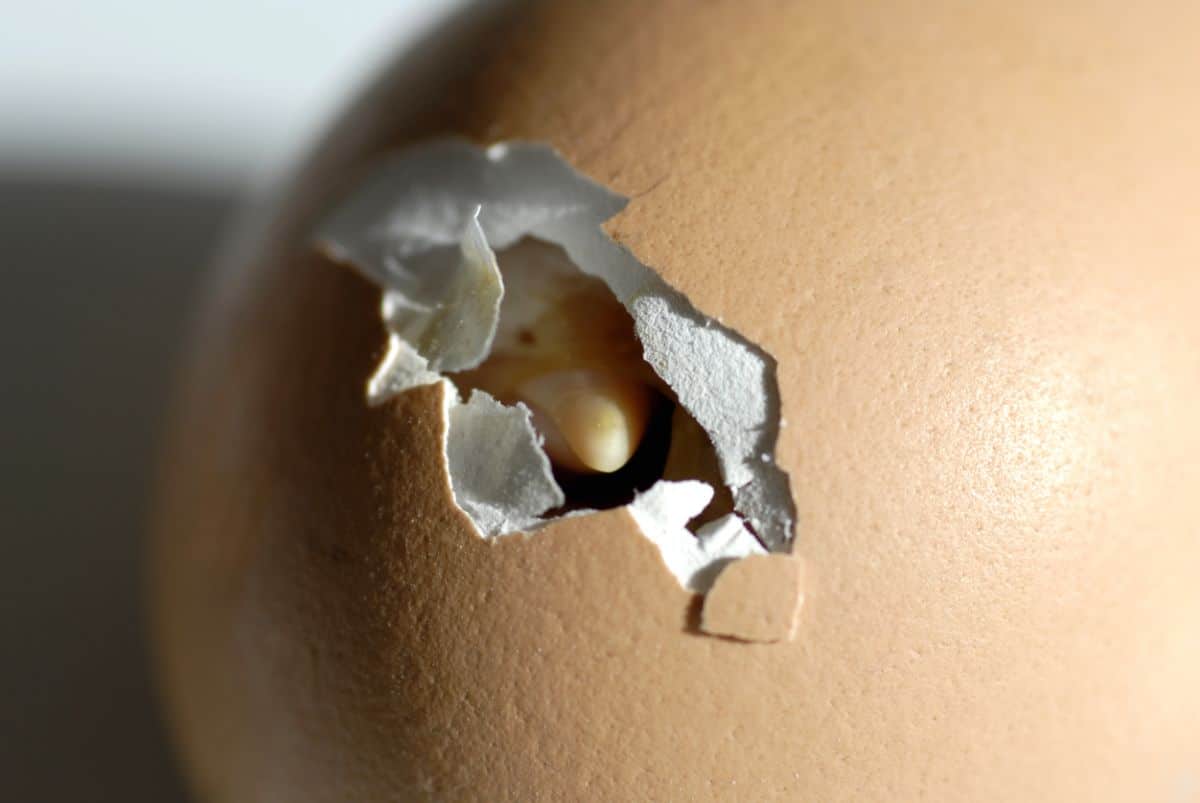Hatching chicken eggs is a fun and rewarding experience. Yet, it’s also a lot of responsibility since your care can effect the chicks’ health. So, how long do chicken eggs take to hatch, and what do you need to know about incubating eggs?
What Do You Need for Hatching Chicken Eggs?
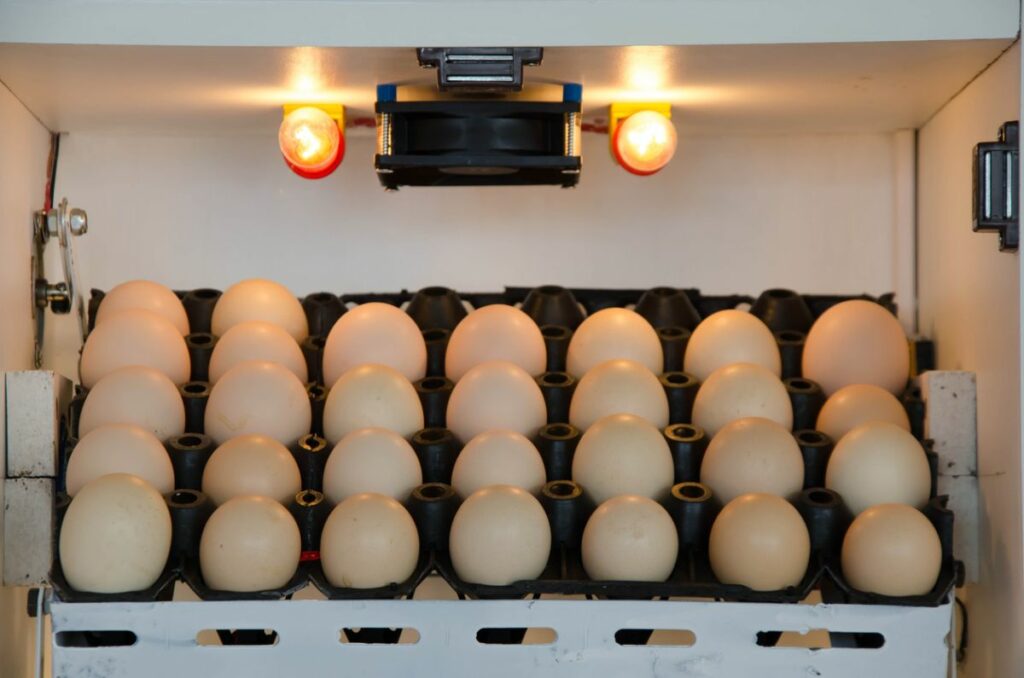
If you’re hatching eggs without the help of a hen, you’ll need an incubator. An incubator is a space with a controlled temperature to keep eggs healthy and prepare them for hatching.
In your incubator, you should have a consistant temperature, an egg tray, a fan for circulating air, and a digital display that can keep track of the humidity, temperature, and hatch day. Some chicken keepers also choose to include an automatic egg turner to make the process easier.
Of course, you’ll need to have fertile eggs to put in the incubator. You can either purchase these from a breeder or breed them yourself if you have hens and roosters. Even before the chicks hatch, you should have a starter chick feed and a container to put food and water in so you’ll be prepared when the chicks hatch.
Have your incubator ready at least ten days before the fertilized eggs arrive. Turn it on to ensure that it’s capable to retaining heat and humidity. Also, make sure the space is clean and dry before putting the eggs inside.
The only method of hatching chicken eggs naturally is by giving them to a broody hen. Yet, using an incubator will give you the best results, so most keepers prefer to hatch the eggs without the help of a hen.
How Long Does it Take for Chicken Eggs to Hatch?
The chicken egg hatching time is 21 days. It’s rare that they will hatch faster or slower than that, but it’s possible if their environment isn’t ideal. Each day has significant development for the unborn chick.
If you notice the chicken eggs not hatching after 21 days, you don’t need to panic. It’s possible for chicks to take longer to hatch, especially if the temperature isn’t ideal.
Temperature and Humidity for Hatching Chicken Eggs
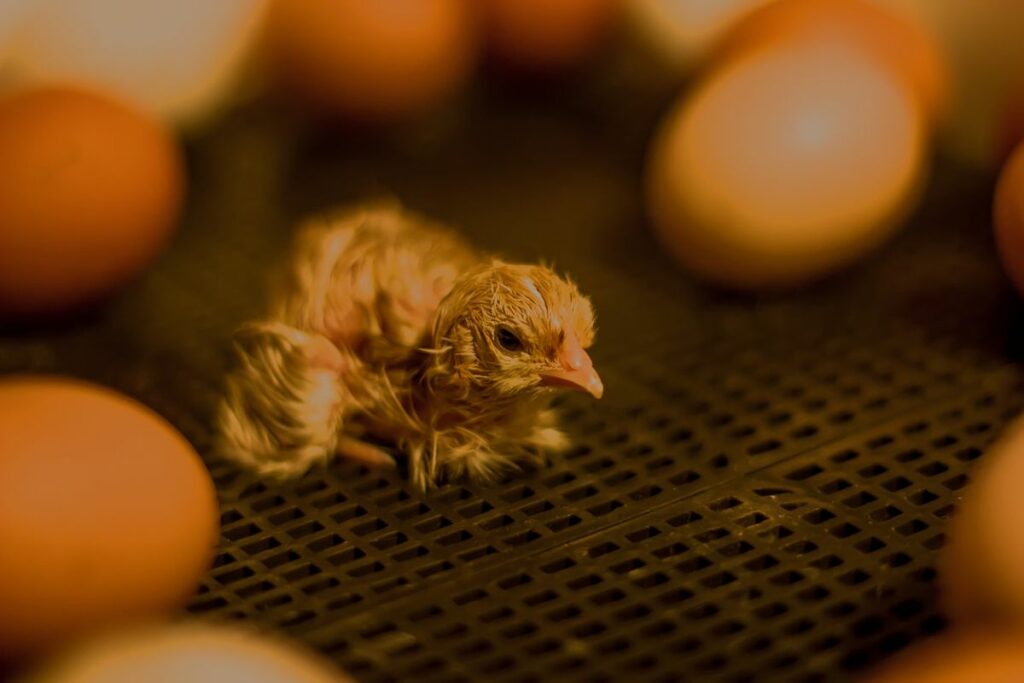
The ideal temperature for hatching chicken eggs in incubator spaces is 100.5 degrees Fahrenheit. However, anywhere between 99 and 102 degrees Fahrenheit is fine. Don’t ever let the temperature fall above or below that range since it could be dangerous for the developing chicks.
The humidity should be at about 50 to 55 percent for the first 17 days, but then, raise it to about 70 percent on the 18th day. After day 18, you can also start to increase the ventilation.
Throughout the entire process, only open the incubator when necessary to prevent heat and humidity from escaping. Always have a thermometer and hygrometer in the incubator to keep track of the incubator’s qualities.
Stages of Chicken Eggs Hatching
Chicks are growing rapidly inside those eggs, so every day matters. Most of the incubation process consists of watching and observing the eggs, but there are a few times where you need to intervene. Here is a step-by-step guide on how to hatch chicken eggs at home.
Setting the Eggs (Day 1)
“Setting the eggs” is a process that occurs as soon as you’ve set up your incubator and gathered the fertilized eggs. You can carefully set the eggs in the egg tray with the larger end of the egg facing up. The incubator should be about 100.5 degrees Fahrenheit and have 50 to 55 percent humidity at that time.
You’ll need to have at least six eggs in the incubator. Having less than that increases the risk of the eggs not hatching at all. Also, chickens are flock animals, so they’re healthier and more content when hatched with several other chicks.
Turning the Eggs (Days 1 – 18)
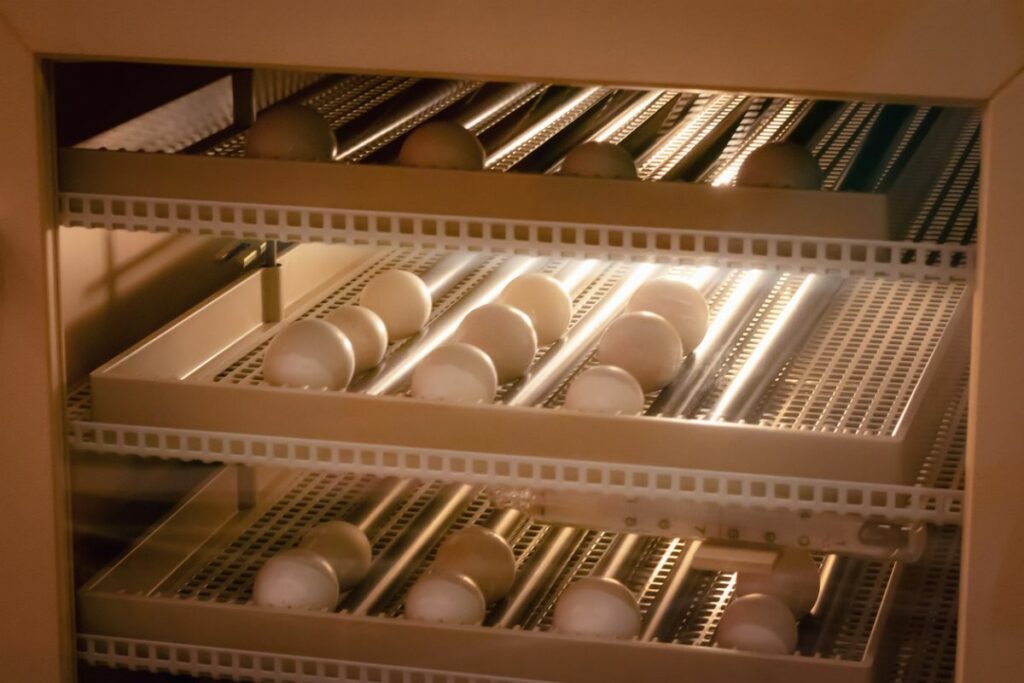
Once the eggs are in the incubator, leave them in there to incubate. Try not to interfere with them unless you have to. The most common reason you’ll have to interact with the eggs is to turn them.
Inside the egg, the yolk often floats to the top, but the embryo should sit on top of the yolk. So, turning the egg keeps the embryo and yolk in the proper position. It also prevents the developing chick from getting stuck to the inside of the egg.
You’ll need to turn the eggs at least three times each day, but some keepers turn them up to five times daily. However, an automatic egg turner is often the most convenient choice if you have a lot of eggs. Plus, it reduces the amount of times you need to open the incubator.
Eggs need to be turned for the first 18 days of the chick’s development. Always wash your hands or wear clean gloves before turning the eggs. Otherwise, the oils on your hands may harm them.
Candling the Eggs (Days 7 – 10)
Between days seven and ten, you can start candling the eggs to see if embryos have developed. Candling refers to when you shine a light on an egg to see the contents inside. The easiest way to do this is by shining a flashlight on the egg. Darker eggs may require brighter lights.
If the egg has no dark spots or other visible areas inside, that means the egg is infertile or died recently. Eggs with a red ring inside also indicate a dead embryo. Eggs with these characteristics should be removed from the incubator. Broken or leaking eggs should also be removed immediately.
Eggs that have a living embryo inside will have visible blood vessels. The embryo of an egg appears as a dark area inside, and you may sometimes see movement. By day 18, the embryo will take up the majority of the egg’s interior.
When candling the eggs, don’t keep them outside of the incubator for longer than five to ten minutes. Only candle the eggs in small groups or one at a time to limit each one’s time away from the heat. Once you’ve candled an egg, put it back in the incubator so it can resume the turning schedule.
Pre-Hatching Stages (Days 18 – 21)
Day 18 is when the embryo should be fully developed inside the egg. If it has developed properly, the unborn chick will prepare for hatching.
To help each chick get ready, end the turning cycle with the larger end of the egg facing up. Then, the chick can properly position itself in the egg. At this time, the temperature should remain at around 100.5 degrees, but you should raise the humidity to 70 percent.
Baby Chicks Hatch (Day 21)
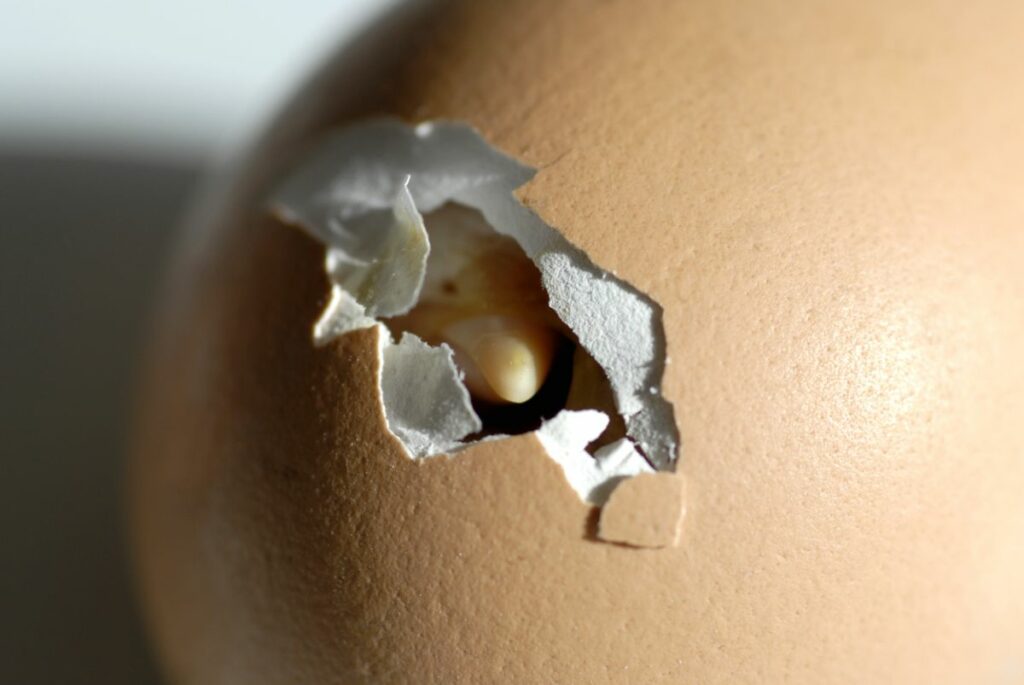
Almost every chicken egg will hatch on day 21. Eggs that were cooled at all before incubation may be slower to hatch, so it’s okay to give chicks a few extra days. If you notice chicken eggs not hatching after 24 days, you may need to try candling to see if they’re still alive.
On hatching day, baby chicks will break out of the shells on their own. Do not interfere with their hatching process. Sometimes, the shell will stick to the chick if the blood vessels haven’t dried up, but it will separate from the chick eventually. Do not pull pieces of the shell off a chick because it could cause bleeding and possibly be deadly.
It can take up to 24 hours for a chick to fully hatch, so be patient and let them do their thing. Most chicks take between five to seven hours to fully hatch, but every bird is different. Once the chicks have hatched, adjust the incubator’s temperature to 95 degrees Fahrenheit.
Even before your chicks hatch, you should have a chicken brooder prepared for them. A brooder is a heated home for chicks to grow up in, which has bedding, food, and water for them. Once the chicks have dry feathers, you can move them into the brooder.
When chickens enter the brooder, the temperature should be between 90 and 95 degrees, and food and water should be available. You won’t know if the chicks are male or female until they’ve hatched, so if you’re not planning to raise roosters, you may need to re-home the males when they grow up.
Frequently Asked Questions
Now that you know the process for hatching chicken eggs, it’s time to get all your lingering questions answered. Here are a few topics that new chicken keepers typically wonder about.
Yes, two chicks can hatch from the same egg, but it’s very rare. In that instance, the two embryos will compete against each other, which usually results in only one chick surviving. Sadly, it’s common for both chicks to die.
Fertile eggs that haven’t been shipped have an 80% chance of growing into healthy chicks. However, fertile eggs that have been shipped have a much lower hatch rate at around 50%. So, if possible, breed chickens yourself or locally buy chicken eggs to hatch.
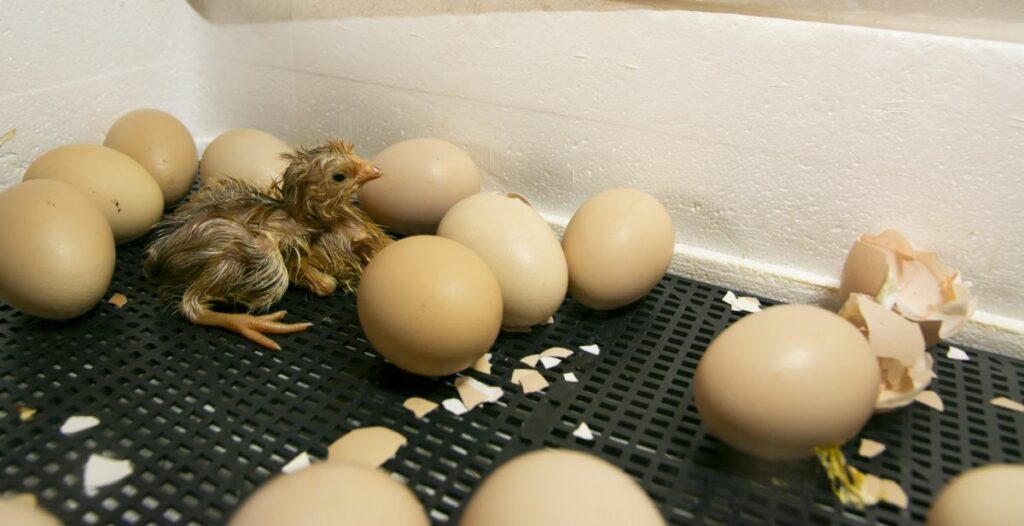
Are You Ready to Start Hatching Chicken Eggs?
Many chicken keepers love the chicken egg hatching process because it’s a fun way to observe how chickens develop. You’ll get to see your future chickens grow up from the moment their egg is laid. Yet, while many keepers find it rewarding, it’s not for everyone.
If you’re not comfortable with being responsible for a group of baby chicks, then that’s okay! You can buy hens as adults or pullets to avoid the added responsibility. Whether or not you raise and incubate chicken eggs is up to you, so consider all that it entails before trying it.
